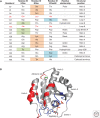The K-Ras, N-Ras, and H-Ras Isoforms: Unique Conformational Preferences and Implications for Targeting Oncogenic Mutants
- PMID: 29038336
- PMCID: PMC6071550
- DOI: 10.1101/cshperspect.a031427
The K-Ras, N-Ras, and H-Ras Isoforms: Unique Conformational Preferences and Implications for Targeting Oncogenic Mutants
Abstract
Ras controls a multitude of cellular signaling processes, including cell proliferation, differentiation, and apoptosis. Deregulation of Ras cycling often promotes tumorigenesis and various other developmental disorders, termed RASopothies. Although the structure of Ras has been known for many decades, it is still one of the most highly sought-after drug targets today, and is often referred to as "undruggable." At the center of this paradoxical protein is a lack of understanding of fundamental differences in the G domains between the highly similar Ras isoforms and common oncogenic mutations, despite the immense wealth of knowledge accumulated about this protein to date. A shift in the field during the past few years toward a high-resolution understanding of the structure confirms the hypothesis that each isoform and oncogenic mutation must be considered individually, and that not all Ras mutations are created equal. For the first time in Ras history, we have the ability to directly compare the structures of each wild-type isoform to construct a "base-line" understanding, which can then be used as a springboard for analyzing the effects of oncogenic mutations on the structure-function relationship in Ras. This is a fundamental and large step toward the goal of developing personalized therapies for patients with Ras-driven cancers and diseases.
Copyright © 2018 Cold Spring Harbor Laboratory Press; all rights reserved.
Figures



Similar articles
-
Non-Redundant and Overlapping Oncogenic Readouts of Non-Canonical and Novel Colorectal Cancer KRAS and NRAS Mutants.Cells. 2019 Dec 3;8(12):1557. doi: 10.3390/cells8121557. Cells. 2019. PMID: 31816869 Free PMC article.
-
Comparison of liver oncogenic potential among human RAS isoforms.Oncotarget. 2016 Feb 9;7(6):7354-66. doi: 10.18632/oncotarget.6931. Oncotarget. 2016. PMID: 26799184 Free PMC article.
-
Calmodulin and IQGAP1 activation of PI3Kα and Akt in KRAS, HRAS and NRAS-driven cancers.Biochim Biophys Acta Mol Basis Dis. 2018 Jun;1864(6 Pt B):2304-2314. doi: 10.1016/j.bbadis.2017.10.032. Epub 2017 Oct 31. Biochim Biophys Acta Mol Basis Dis. 2018. PMID: 29097261 Review.
-
Structural fingerprints, interactions, and signaling networks of RAS family proteins beyond RAS isoforms.Crit Rev Biochem Mol Biol. 2018 Apr;53(2):130-156. doi: 10.1080/10409238.2018.1431605. Epub 2018 Feb 19. Crit Rev Biochem Mol Biol. 2018. PMID: 29457927 Review. No abstract available.
-
Antibody targeting intracellular oncogenic Ras mutants exerts anti-tumour effects after systemic administration.Nat Commun. 2017 May 10;8:15090. doi: 10.1038/ncomms15090. Nat Commun. 2017. PMID: 28489072 Free PMC article.
Cited by
-
Ras Isoforms from Lab Benches to Lives-What Are We Missing and How Far Are We?Int J Mol Sci. 2021 Jun 17;22(12):6508. doi: 10.3390/ijms22126508. Int J Mol Sci. 2021. PMID: 34204435 Free PMC article. Review.
-
The Ins and Outs of RAS Effector Complexes.Biomolecules. 2021 Feb 7;11(2):236. doi: 10.3390/biom11020236. Biomolecules. 2021. PMID: 33562401 Free PMC article. Review.
-
Oncogenic KRAS: Signaling and Drug Resistance.Cancers (Basel). 2021 Nov 9;13(22):5599. doi: 10.3390/cancers13225599. Cancers (Basel). 2021. PMID: 34830757 Free PMC article. Review.
-
RAS variant signalling.Biochem Soc Trans. 2018 Oct 19;46(5):1325-1332. doi: 10.1042/BST20180173. Epub 2018 Oct 3. Biochem Soc Trans. 2018. PMID: 30287508 Free PMC article. Review.
-
Targeting RAS phosphorylation in cancer therapy: Mechanisms and modulators.Acta Pharm Sin B. 2021 Nov;11(11):3433-3446. doi: 10.1016/j.apsb.2021.02.014. Epub 2021 Feb 25. Acta Pharm Sin B. 2021. PMID: 34900528 Free PMC article. Review.
References
Publication types
MeSH terms
Substances
LinkOut - more resources
Full Text Sources
Other Literature Sources
Research Materials
Miscellaneous
